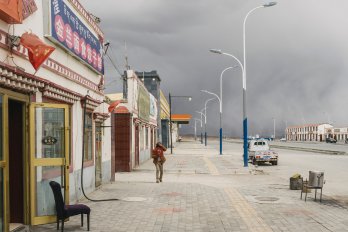In my family, when I’m at home, dinnertime is a daily ritual. On a Friday in December, the smells of a full Korean dinner fill our cramped apartment in north Toronto. Many storeys below, darkness falls over the last of the rush-hour cars. My sister and I move several Tupperware containers of side dishes—kimchi, seaweed salad, pickled cucumbers—onto the table. As we set out the cutlery, my mother’s phone rings. It is my father. Her hands filled by a bowl of hot soup, my mother instructs my sister to answer it.
“What did you do today?” my father asks.
“I went to school,” says my sister. She recently started university. She tells him that her classes end next week and exams start after that. Her description of university life is matter of fact, contrasting with the detailed accounts of her day she excitedly relates to me every evening. When my sister is done giving her briefing, it is my turn to take the phone.
My parents live in two different countries, but they are not divorced or separated. As we set the dinner table each night in Toronto, my father drives to work in Seoul, South Korea, and calls us on his Bluetooth device. Despite happening daily, these phone conversations don’t usually go into great depth or last more than a couple of minutes. They serve more as reminders of our family-ness: the act of checking in is more important than the content of the check-in itself.
In South Korea, long-distance families like ours are called “wild geese families” because one person, usually the father, makes trans-Pacific voyages that echo the seasonal migrations of geese. In the context of the Chinese diaspora, these families are commonly called “astronaut households”; geographer Lan-Hung Nora Chiang describes them as (usually nuclear) families where “one family member returns to East Asia to maximize their earnings while the rest of the family remain in Canada,” usually to improve the children’s educational opportunities. In a lot of ways, prolonged separation is easier now than it has ever been, as apps enable free international calling for anyone with an internet connection.
Still, prolonged separation is far from ideal; the best option would be for families to stay together. The Canadian government states that family reunification is a policy priority, but in practice, immigrants still face many obstacles to building new lives in Canada—obstacles that can pull families apart.
In the early 2000s, my father, a young, ambitious earth scientist with a master’s degree, quit his prestigious job in South Korea to bring his family to Canada. To even qualify for jobs that suited his skill level, he needed Canadian credentials, so he applied to Canadian graduate programs. My parents were disadvantaged in Canada not only because their skills and experience were not recognized but also because of linguistic and cultural barriers and their lack of professional networks. In the end, despite his efforts, my father could not find an adequate job. Having received an attractive offer in South Korea, he returned. Now he advises the government and other clients on environmental policy, renewable energy, and carbon taxes.
As was the case in most Western nations, Canada’s immigration policy maintained racial and ethnic restrictions into the 1960s, partly because individual immigration officers could exercise a large degree of discretion about whom to admit. Responding to criticisms of this system, as well as to labour-market demands, the government introduced the points system currently in use. This system assigns values to certain criteria to decide whether prospective immigrants qualify for permanent residence. Immigration is still restrictive but on the grounds of seemingly neutral qualities like education, age, language skills, and employability. After the introduction of the points system, immigrants increasingly came from a wider range of places outside of the previously favoured Western European countries. But, as was the case with my family, immigration policies prioritized skills that turned out to be less valuable than Canadian experience.
Experts have spent decades pointing out that employers’ preferences for Canadian experience—explicitly stated or not—effectively exclude many people with foreign credentials and work experience. Some immigrants have years of work experience and advanced degrees from their home countries, which count in their favour when they apply to come to Canada. Once they get here, though, it becomes clear that what matters when it comes to getting a job is having worked in Canada already. A report from the Ontario Fairness Commissioner found that, in 2011, internationally educated immigrants were half as likely to be employed in their professions (licensed professions include engineering, nursing, and accounting) as their Canadian-born and -educated peers. While these large discrepancies might be attributable to various factors, it is clear that immigrant professionals struggle to find employment at their skill levels. This mismatch between the points system and employment prospects can be the reason families like mine end up separated. In recent years, the Canadian government has introduced immigration policies to explicitly favour people who already have work experience or job offers in Canada. This meant the government policies took greater consideration of employers’ preferences, but these policies continue to put the onus on the immigrant and reinforce the exclusion of diverse backgrounds from the Canadian workforce.
Another cause of family separation is our immigration policy’s focus on short-term labour needs. Between 2005 and 2012, the number of temporary foreign workers more than doubled, even as the number of permanent-resident immigrants remained relatively stable. Many of these temporary workers occupy low-wage jobs in sectors such as construction and agriculture and are not formally guaranteed the right to stay in Canada or to reunite with their families. Recent pilot programs allow caregivers to come to Canada with their families, but they still have to meet strict education and language requirements. Financial burdens pose an even stronger constraint on family life: under conditions of precarious, low-wage work, it is even harder for these workers to fly back home to see their families or even to talk to them regularly.
Regardless of cause, these arrangements inevitably change family dynamics. Jeong-Eun Jeong, a “goose mother” of four in Toronto, has been living apart from her partner for about four years. They had immigrated together, intending to settle in Canada permanently, but her partner could not find a suitable job. In the end, they made the difficult decision to live as a goose family.
Her youngest child was not yet two years old. “There aren’t many benefits,” she says about the goose-family lifestyle. Aside from the practical difficulties of raising her children alone, Jeong says that she misses spending quality time with her family. “I really envy my neighbours who can go on short camping trips on the weekends,” she says.
During one of my father’s visits, I woke up to the sound of him talking on the phone. He was telling someone how to get into his house in Gunpo, a small city near Seoul: explaining the passcode to the building and where to find his key. Concerned, I rushed out of bed to ask if everything was okay. It turned out that, before leaving, he had asked a coworker to feed his goldfish for him. I forgot about this incident until later that year, when the rest of my family visited him. He gave us a two-minute tour of his small studio, ending in his proud display of the goldfish. “This one’s gotten pretty fat,” he said as he reached inside the tank to prod it. It occurred to me only then that, every evening, this is the company he comes home to.
Our immigration system does not have to be this way. Canada can implement policies that enable the recognition of immigrants’ skills and qualifications and can encourage professional associations to create similar guidelines. Recognizing that those with families to feed and take care of are less able to go back to school or take unpaid internships, we should help immigrants gain experience in Canada. Our policies should also make it easier for immigrants and temporary workers to bring their families with them. Migrant-worker advocacy groups have long been fighting for “status on arrival,” granting permanent residence to migrant workers as soon as they arrive in Canada. More generally, we need an approach to immigration that sees immigrants as humans and neighbours rather than as sources of labour that can move flexibly across borders, untethered to family and community. Families come here for new starts, new opportunities, and new challenges. But without changes to our system, we risk alienating the very people we are encouraging to move here. If one family member ends up returning to their home country, the rest of the family is caught in limbo, unable to be fully present in one place or the other.
A few months ago, my mother travelled to South Korea to visit family. She sent me selfies of her and my father out to dinner. I tried to imagine their conversations but couldn’t—for the simple reason that it had been so long since I had heard them talking together. Waiting at the airport in Seoul to fly back to Toronto, my mother called me. “Your grandparents want me to come back to Korea permanently,” she said. Now that my sister is in university, they see my mother’s job as done. My mother carries much of the burden of our uncertainty, as familial and cultural expectations on both sides of the Pacific pull her in different directions. “I want to be with my children, but I’ve got a husband and parents too.”





